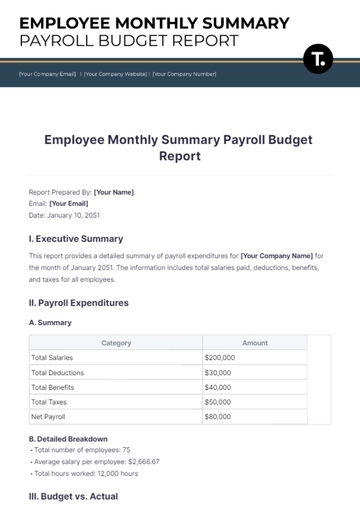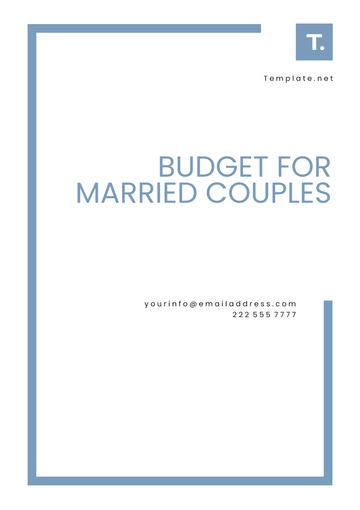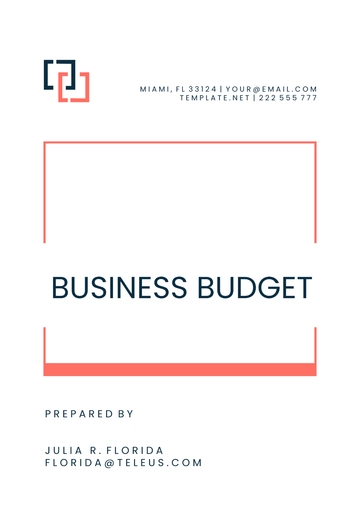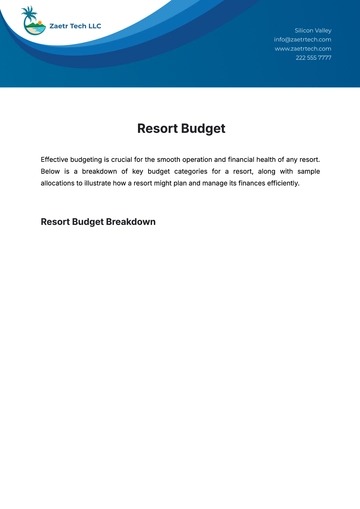Free Restaurant Budget Report
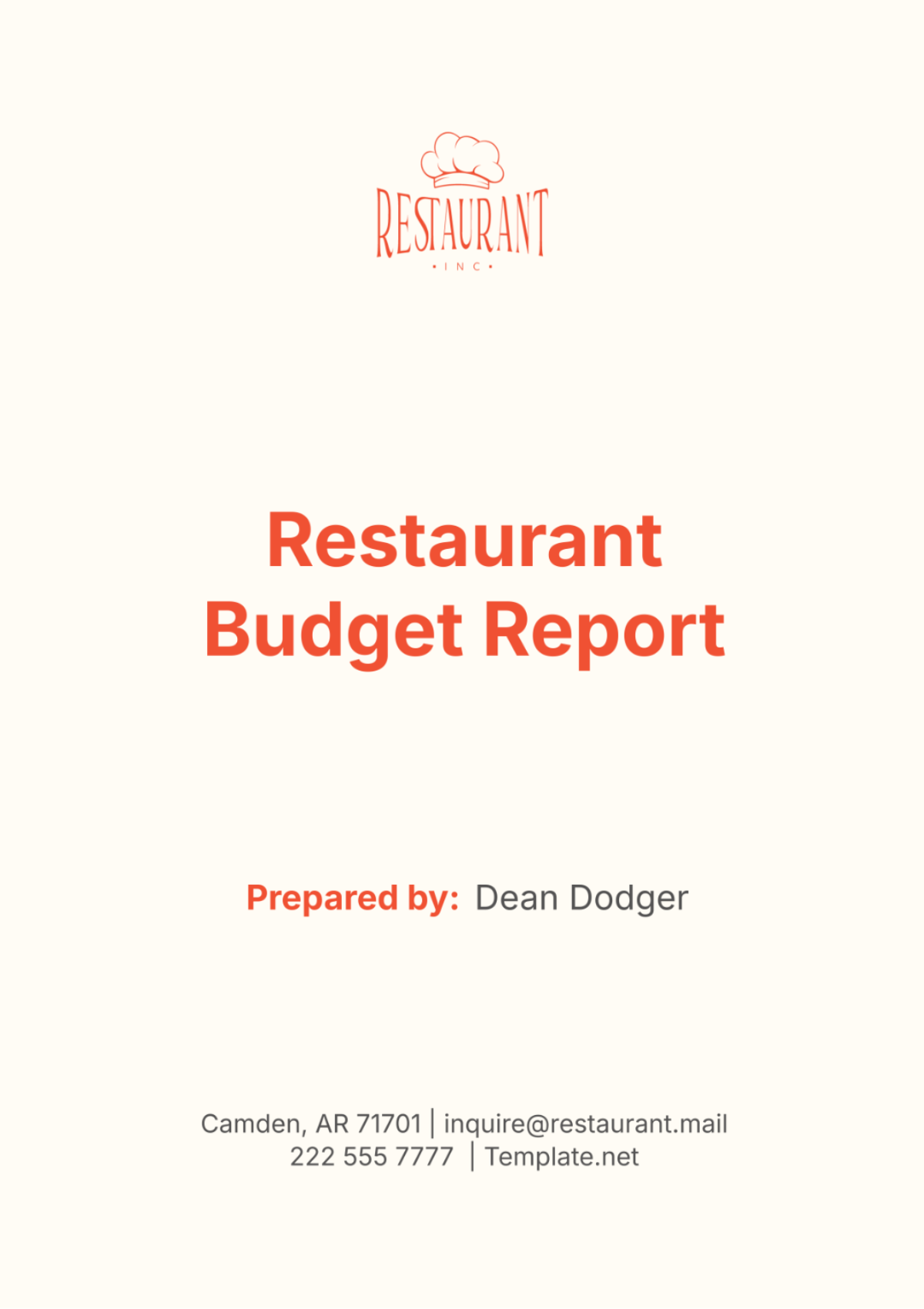
I. Introduction
The Restaurant Budget Report serves as a vital instrument in managing the fiscal landscape of [Your Company Name]. It provides a detailed analysis of all financial transactions, from revenue generation through sales to detailed expenditure on ingredients, staff wages, and utility costs. This meticulous approach helps in detecting inefficiencies, planning capital investments, and ensuring sustainable growth. The primary objective is to streamline operations and boost the overall financial performance of the establishment.
In this report, we dissect the components of our budget to offer a transparent view of our financial health. We delve into the specifics of food cost percentages, labor ratios, and operational expenses that are critical for maintaining a profitable business model. Each category is scrutinized to identify trends, unexpected variances, and opportunities for cost savings, which are fundamental for informed decision-making and strategic planning.
Finally, the Restaurant Budget Report highlights the effectiveness of our current financial strategies and sets the stage for proactive adjustments. It is not merely a record of numbers but a dynamic tool that influences decision-making on pricing, cost management, and marketing strategies. By understanding where we stand financially, we can better predict future needs and adjust our business model to meet market demands and maximize profitability.
II. Summary of Key Financial Metrics
This section offers a detailed summary of the key financial metrics for the reporting period. It juxtaposes budgeted amounts against actual spending, providing clear insights into financial performance across various categories including food and labor costs, overheads, and marketing expenses. By examining variances and annotating significant deviations, this analysis is instrumental in guiding fiscal adjustments and strategic planning to optimize financial health and operational efficiency.
Category | Budgeted Amount | Actual Spend | Variance | Notes |
|---|---|---|---|---|
Food Costs | $50,000 | $45,000 | - $5,000 | Efficient ingredient procurement and menu pricing strategies. |
Labor Costs | $55,000 | $55,000 | $0 | Slightly above budget due to overtime during peak seasons. |
Overheads | $20,000 | $19,500 | - $500 | Close adherence to fixed cost management. |
Marketing & Advertising | $5,000 | $5,000 | $0 | On budget, reflecting targeted and effective promotional efforts. |
Miscellaneous Expenses | $2,500 | $3,000 | + $500 | Due to unforeseen circumstances like emergency repairs. |
III. Detailed Breakdown
This section delves into a comprehensive analysis of our restaurant's specific financial categories, elucidating on food costs, labor expenses, overheads, and marketing investments. Each category's budget allocation is evaluated against the actual spend, highlighting effective strategies and areas for improvement. Insights from this detailed breakdown are crucial for enhancing operational efficiencies, reducing costs, and optimizing overall financial performance. By closely monitoring these metrics, we ensure the sustainability and profitability of our operations.
A. Food Costs
In analyzing this month's food costs, the budgeted 30% of total revenue was effectively managed, reflecting a noteworthy diligence in cost control measures. The actual expenditure of $45,000, against a forecasted $50,000, underscores our restaurant’s strategic purchasing decisions and effective menu pricing that adapt to fluctuating market prices and customer preferences. These outcomes stem from our proactive approach to vendor negotiations and adapting our offerings based on seasonal availability, which ensures both quality and cost-efficiency.
To maintain and extend these cost efficiencies, ongoing scrutiny of purchase orders and inventory management is crucial. Implementing rigorous waste management practices has also played a significant role in curtailing unnecessary expenses, highlighting the importance of sustainability in our operations. Looking ahead, expanding our bulk purchasing and exploring collaborations with new local suppliers could drive costs down further, bolstering our profitability while supporting community-based businesses.
Future strategies will focus on enhancing our procurement process and refining our menu design to maximize profit margins without compromising on quality. By leveraging data analytics, we can better predict trends and adjust our food orders accordingly, ensuring that we are both meeting customer demand and managing food costs effectively. Additionally, fostering stronger relationships with suppliers can lead to more favorable pricing and exclusive deals, further optimizing our food cost management.
B. Labor Costs
Labor costs this month met the anticipated budget, with an actual expenditure of $55,000, indicating a balanced management of human resources despite challenges. The exact alignment with our budget, however, was strained by unexpected overtime during peak seasons, suggesting a need for more flexible staffing solutions or better workload distribution. This scenario highlights the dynamic nature of restaurant operations and the need for responsive labor management strategies that not only meet customer service standards but also control costs.
Recommendations for improving labor cost efficiency include the introduction of more robust scheduling systems that minimize idle time and prevent overstaffing. Cross-training employees is also essential, as it allows for a more versatile workforce that can cover multiple positions as needed, particularly during unexpected staff shortages or peak times. Moreover, precise monitoring of clock-in and clock-out times will help in enforcing labor policies and avoiding unnecessary overtime payments.
Continual evaluation of staffing needs against customer footfall will be essential going forward. By implementing technology solutions that offer real-time data on restaurant occupancy and peak hours, we can adjust our staffing levels more accurately, ensuring that we meet service demands without compromising our financial goals. Such strategic oversight will be instrumental in keeping labor costs within budget while maintaining high standards of customer service and employee satisfaction.
C. Overheads
This month, our overheads—comprising utilities, rent, and maintenance—reflected strong financial stewardship, registering a spending of $19,500 against a budget of $20,000. This favorable variance demonstrates our commitment to efficient fixed cost management, supported by diligent adoption of energy-saving measures and routine maintenance practices. These efforts not only contribute to reducing operational costs but also align with our sustainability objectives, reinforcing the role of eco-friendly practices in cost management.
Looking ahead, it is crucial to pursue additional cost-reduction strategies to further lower overhead expenses. Renegotiating lease terms could potentially decrease our monthly rent obligations, while investments in renewable energy solutions, such as solar panels, could substantially cut long-term utility costs. These strategic decisions are aimed not only at cost savings but also at enhancing the restaurant's reputation as an environmentally responsible business.
Moreover, by maintaining a proactive approach to facility management—regularly updating equipment and implementing preventative maintenance—we can avoid costly breakdowns and disruptions to service. Continual review and optimization of service contracts and utility plans will also play a key role in keeping overhead costs under control, ensuring they contribute positively to our overall financial health.
D. Marketing and Advertising
Our marketing and advertising efforts this month effectively utilized the budget of $5,000, reflecting precise and strategic deployment of resources that maximized customer engagement and retention. The focus on targeted advertising and the strategic use of social media have been particularly effective, allowing us to reach our desired audience with a high degree of precision. These initiatives have not only bolstered our visibility but have also driven significant patronage, which is critical in the competitive restaurant industry.
To enhance the effectiveness of our marketing expenditures, ongoing analysis of the return on investment (ROI) across various channels is essential. This analysis will inform future budget allocations, ensuring funds are directed towards the most productive strategies, whether digital campaigns, community events, or traditional media. Adjusting our strategies based on performance metrics will help optimize spending and increase overall marketing efficiency.
Additionally, exploring new promotional opportunities such as seasonal promotions, collaborative campaigns with local businesses, and loyalty programs can further amplify our market presence and customer base. These initiatives should be designed to not only attract new customers but also to deepen relationships with existing patrons, creating a loyal community around our brand which is essential for sustained success.
E. Miscellaneous Expenses
Miscellaneous expenses this month exceeded the anticipated budget, totaling $3,000 due to unforeseen circumstances such as emergency repairs. This variance highlights the unpredictable nature of restaurant operations and underscores the importance of maintaining a flexible budget to accommodate such unexpected costs. Implementing stricter monitoring and approval processes for non-regular expenditures can aid in better managing these costs.
To mitigate the impact of these unforeseen expenses in future budgets, increasing our contingency fund is advisable. This adjustment will provide a more realistic financial cushion, allowing us to handle unexpected situations without compromising our financial stability. Additionally, a more aggressive preventive maintenance schedule could reduce the frequency and severity of emergency repairs, thereby controlling these sporadic expenses more effectively.
Investing in comprehensive training for staff on equipment use and routine maintenance checks can also decrease the likelihood of costly breakdowns. Such proactive measures not only help in managing miscellaneous expenses but also ensure a smoother operational flow, contributing to the overall efficiency and profitability of the restaurant.
IV. Conclusion and Recommendations
The Restaurant Budget Report underscores our solid financial management in several key areas such as food costs and overhead expenditures, which demonstrate our commitment to efficiency and sustainability. Despite these successes, there are vital areas requiring focused improvement, notably in labor cost management and preparation for unforeseen expenses. By refining our operational strategies and maintaining rigorous financial oversight, we position the restaurant to maximize profitability and ensure its long-term financial stability.
To address these challenges effectively, we propose the following strategic recommendations, which are designed to tighten fiscal discipline and enhance operational efficiency:
Recommendation | Purpose | Expected Outcome |
|---|---|---|
Optimize Staffing Schedules | Reduce labor costs by minimizing reliance on overtime | Lower operational costs, improved staff efficiency |
Enhance Procurement and Waste Management | Maintain low food costs through better sourcing and waste control | Cost savings, reduced environmental impact |
Increase Contingency Funds | Prepare financially for unexpected expenses | Enhanced financial stability |
Analyze Marketing ROI | Allocate marketing budget more effectively | Higher customer engagement, improved sales |
Implement Cost-Saving Measures in Overheads | Reduce fixed expenses like utilities and rent | Long-term cost reductions, increased profitability |
By implementing these recommendations, [Your Company Name] can improve its financial performance and adapt more dynamically to both expected and unforeseen challenges, ensuring continued success in a competitive industry.
- 100% Customizable, free editor
- Access 1 Million+ Templates, photo’s & graphics
- Download or share as a template
- Click and replace photos, graphics, text, backgrounds
- Resize, crop, AI write & more
- Access advanced editor
Discover the ultimate Restaurant Budget Report Template at Template.net. This fully editable and customizable template allows you to efficiently manage your restaurant's finances. Perfectly editable in our AI Editor Tool, it ensures effortless customization to suit your unique needs. Elevate your budgeting process and streamline financial tracking with a professional touch. Make informed decisions effortlessly—download our template now!
You may also like
- Budget Sheet
- Personal Budget
- Non Profit Budget
- Monthly Budget
- Project Budget
- HR Budget
- Company Budget
- Home Budget
- Weekly Budget
- College Budget
- Business Budget
- Construction Budget
- Small Business Budget
- Hotel Budget
- Annual Budget
- Home Renovation Budget
- Household Budget
- Student Budget
- Grocery Budget
- Marketing Budget
- Corporate Budget
- Startup Budget
- Manufacturing Budget
- Church Budget
- University Budget
- Annual Budget Plan
- Event Budget
- Operating Budget
- Travel Budget
- Food Budget
- IT and Software Budget
- School Budget
- Real Estate Budget
- Sales Budget
- Conference Budget
- Budget Finance
- Freelancer Budget
- Budget Advertising



